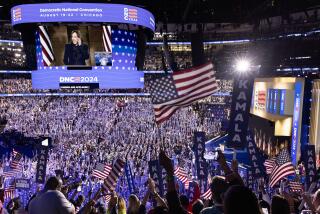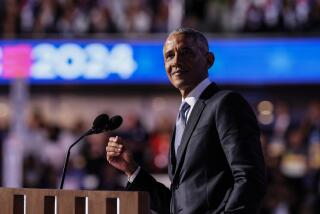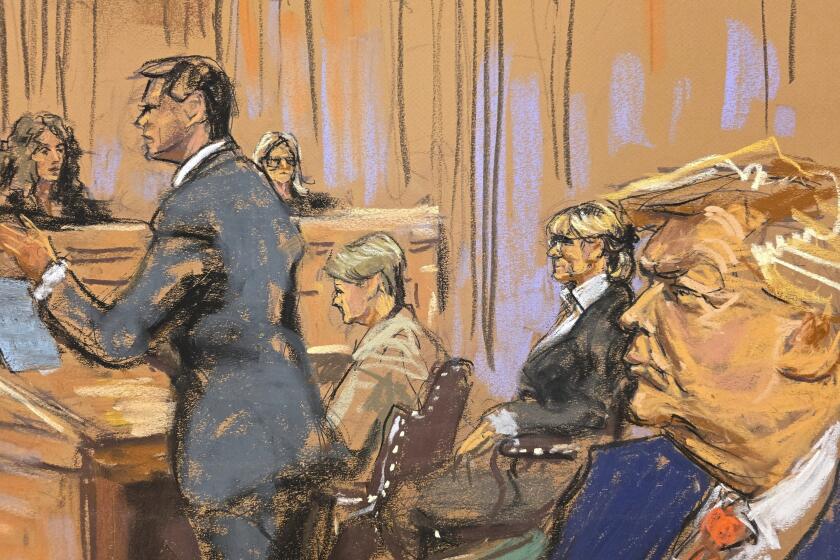Column: Democrats, uncurb your enthusiasm
Polling hasn’t brought much good news to Democrats this spring. In the latest blow, a Pew Research survey for USA Today reported Monday that 47% of voters said they expect to vote for Republican candidates in November’s congressional election, against only 43% who plan to vote Democratic. If those numbers hold up, control of the Senate is likely to flip from the Democrats to the GOP.
And if that weren’t enough, the enthusiasm gap is back. Most Republican voters report being certain they will vote this fall; by comparison, many Democrats are wavering. And one reason for Democrats’ irresolution, it appears, is President Obama: “At this early point in the campaign, Obama inspires far less enthusiasm among Democratic voters than he did four years ago,” Pew reported.
The Democrats’ core problem in recent congressional elections has been simple: Their voters don’t show up. They flock to the polls in presidential elections, but when the contest is merely for seats in the Senate and the House of Representatives, they don’t leave the couch.
As Sasha Issenberg wrote recently in the New Republic, in a congressional election there are now two Americas: one of “reliable voters” who turn out every two years; the other of “unreliable voters” who don’t. And Republicans have way more of the reliable kind than Democrats do.
Overcoming that gap is the great challenge for Democrats this year, which is why they’ve launched an audacious strategy that, if it works, could change the way future congressional campaigns are waged.
It’s based on the Obama campaign’s success in turning out more votes than expected in 2012 through a massive field operation that knocked on doors and made telephone calls to persuade wavering Democrats and Obama-friendly independents to vote.
The goal, Matt Canter of the Democratic Senatorial Campaign Committee told me, is “to make the electorate in 2014 look more like the electorate in 2012.”
The DSCC says it plans to spend $60 million on field operations this year, a huge increase from the $7.5 million it spent in 2010 — when Democrats lost their majority in the House.
“Turnout is vital, but enthusiasm has almost nothing to do with turnout,” says Mark Mellman, a veteran Democratic strategist. “Turnout has more to do with habit than with anything else. If you know whether someone voted in the last congressional election, you know whether they’re likely to vote in this one.”
Mellman has direct experience overcoming an enthusiasm gap. In 2010, he helped Senate Majority Leader Harry Reid (D-Nev.) win reelection despite the fact that Nevada Republicans were significantly more gung-ho than Democrats were. “We got them to come to the polls anyway,” he said.
The Democratic effort has two main parts: message and mechanics.
The message involves both positive and negative components. Democrats will portray themselves as fighting for what they call a “fair shot” agenda, including a higher minimum wage and pay equity for women, and they’ll portray Republicans as defending the top 1% of the income scale at the expense of everyone else.
Those messages aren’t intended solely to mobilize unreliable Democrats. They’re also aimed at a category of voters the strategists call “persuadables,” the people once known as swing voters. In this case, the targets are blue-collar workers who resent the 1%, and women (especially unmarried women) who worry about social conservatives.
It won’t be a soaring, inspirational campaign, and Republicans are already denouncing it as trashy and cynical. But the Democrats’ backs are against the wall, and, as columnist Finley Peter Dunne wrote in 1895, politics ain’t beanbag.
Equally important, the Democrats say they plan to devote far more money and effort than before to the mechanics of voter turnout: the canvassing, phone calls and individualized mailings that can get wavering voters to show up.
Indeed, Mellman says, “Research suggests that mechanics matter more than message. I’m not encouraging messageless campaigns; message still is important. But message won’t matter much if you don’t get voters to the polls.”
The DSCC says it hopes to help register tens of thousands of new voters, including African Americans in Georgia, Louisiana and Arkansas, where Senate seats are at stake. And by November, the DSCC plans to have no fewer than 4,000 paid field organizers in at least a dozen states.
Will all this on-the-ground effort make the difference in November?
The odds are still against the Democrats, if only because they are trying to hold on to endangered Senate seats in no fewer than seven states where Mitt Romney won in 2012. Republicans plan to match their spending and, if they can, much of the field effort. And so far the GOP hasn’t nominated any eccentric candidates who look like easy pickings, as they did in 2010 and 2012.
But if the Democrats’ big new field operation manages to increase their turnout by even a percentage point or two, it could change the way future congressional campaigns are run.
More to Read
A cure for the common opinion
Get thought-provoking perspectives with our weekly newsletter.
You may occasionally receive promotional content from the Los Angeles Times.











